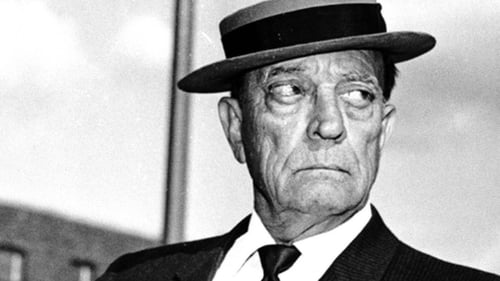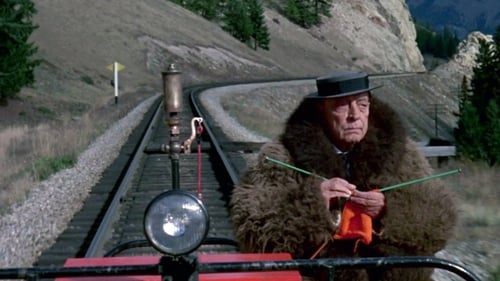Julian Biggs
Birth : , Port Perry, Ontario, Canada

Writer
This feature-length documentary paints a lively portrait of Father of Confederation and first premier of Newfoundland Joseph Roberts Smallwood, or "Joey," as he is known to most Canadians. Following one of Canada’s most colourful political figures during a two-and-a-half-month period that included a stormy Liberal leadership convention, the film reveals a man misunderstood even by his close associates.

Producer
This feature-length documentary paints a lively portrait of Father of Confederation and first premier of Newfoundland Joseph Roberts Smallwood, or "Joey," as he is known to most Canadians. Following one of Canada’s most colourful political figures during a two-and-a-half-month period that included a stormy Liberal leadership convention, the film reveals a man misunderstood even by his close associates.

Director
This feature-length documentary paints a lively portrait of Father of Confederation and first premier of Newfoundland Joseph Roberts Smallwood, or "Joey," as he is known to most Canadians. Following one of Canada’s most colourful political figures during a two-and-a-half-month period that included a stormy Liberal leadership convention, the film reveals a man misunderstood even by his close associates.

Producer
A boy's carved boat travels through the Canadian wilderness until it reaches the ocean.

Producer
The story of two young women who go to the city to work in a dress factory, and who share a room to ease their expenses and their loneliness. The film shows the currents that brought them together and the facets of their natures that first made them seem compatible but eventually drove them apart. Their story reflects, to a degree, the situation of anyone who has ever shared the life of another.

Producer
In the fall of 1964, just over a year before his death, Buster Keaton traveled to Canada to make The Railrodder, a short subject that now enjoys a small cult following. Documenting this mobile production in fascinating and unexpected detail, Buster Keaton Rides Again offers a rare glimpse of the comedy legend’s temperament, philosophies, hobbies, marriage (his third), and the occasionally combative creative process behind the scenes. An intimate look at one of cinema’s most enduring legends.

Producer
After literally swimming across the Atlantic Ocean, an Englishman takes a country trip across Canada on a railcar.

Producer
A dizzying view of Manhattan in the 1960s, the tallest town in the world, and the men who work cloud-high to keep it growing. They are the Mohawk Indians from Kahnawake, near Montréal, famed for their skill in erecting the steel frames of skyscrapers. The film shows their nimble work, high above the pavement, but there are also glimpses of the quieter community life of the old Kahnawake Reserve.

Editor
If you erase the people of downtown America, the effect is bizarre, not to say disturbing. That is what this film does. It shows the familiar urban scene without a soul in sight: streets empty, buildings empty, yet everywhere there is evidence of recent life and activity. At the end of the film we learn what has happened.

Producer
If you erase the people of downtown America, the effect is bizarre, not to say disturbing. That is what this film does. It shows the familiar urban scene without a soul in sight: streets empty, buildings empty, yet everywhere there is evidence of recent life and activity. At the end of the film we learn what has happened.

Director
If you erase the people of downtown America, the effect is bizarre, not to say disturbing. That is what this film does. It shows the familiar urban scene without a soul in sight: streets empty, buildings empty, yet everywhere there is evidence of recent life and activity. At the end of the film we learn what has happened.

Producer
This short drama is a portrait of Quebec lawyer and politician Louis-Joseph Papineau (1786-1871). A proud, defiant man, skillful in parliamentary debate, and Speaker of the Lower House, his heart was with the people being pillaged by the business elite. When legislation became the instrument of private advantage, Papineau brought government to a standstill. - NFB

Director
The story of a fishing family, their daily lives, and the son’s wish for a modern boat

Producer
In Toronto, early twenty-somethings Judy Monroe and Roy Kirby are in love and are planning to get married. They understand the obstacles they are facing as husband and wife as Judy is white and Roy is black.

Producer
A dramatization of Canadian author W.O. Mitchell's penetrating story about the racial prejudice encountered by a Polish immigrant farmer in a rural Saskatchewan community.

Producer
Howard Mitchell is a responsible young man who will soon be graduating from high school. He works at Resnick's Pharmacy to be able to earn enough money to put himself through college. But in part because of the life lessons he learns from Mr. Resnick through Mr. Resnick's somewhat cynical observations of the customers that come into the pharmacy, Howard is intrigued by an offer from George, his best friend, to tour Canada following their graduation instead of going directly into a post-secondary institution. This trip would not be a vacation, but rather an opportunity to see what life has to offer by meeting people from different parts of the country, while they work odd jobs along the way. This idea goes against the sensibilities of Howard's parents and Howard's girlfriend, Mary, who see this trip as just another impetuously stupid idea by flaky George. Howard has to try and reconcile all these competing forces in his life. —Huggo

Producer
This feature-length drama, originally broadcast in two parts as part of the NFB television series "Perspective," tells two sides of the same story to illustrate the lack of communication between employer and employee. The story takes us into a fictional paper company to meet two men who, despite having similar goals, are at odds with each other. First, we see the tale unfold from the point of view of the employee, and then we get to see the same story retold through the eyes of the employer.

Producer
Two generals prepare for battle at the Plains of Abraham.

Producer
The big whale round-up at Trinity Bay, Newfoundland, is brought to the screen with a realism not often found in fish stories. Cameras are on hand to record the annual sea drama as herds of pothead whales are driven inshore by fishing boats and killed in shallow water. There is tense excitement as, their escape cut off, the marine monsters fight for their lives. Reporter Fred Davis is told about the commercial uses of whale meat and whale products, particularly in mink farming.

Producer
Fred Davis introduces us to Canadian Air Force operations in Zweibrucken, West Germany. Follow Green Section as they perform drills and explain what it takes to be a fighter pilot.

Producer
This short documentary profiles the uniquely cloistered wildlife of Sable Island, known as the “Atlantic graveyard” due to its inhospitable conditions. Barren sands and endless gales proved too much for human settlement on this island off the coast of Nova Scotia. Only a small group of researchers and maintenance people occupy the island; horses run wild, seals and birds multiply profusely, and the Ipswich sparrow has found a fruitful breeding ground for itself. Sable Island provides a perfect opportunity to observe nature in an untouched, organic laboratory.

Director
People are interviewed in Dresden, Ontario, to sample local attitudes towards racial discrimination against black people that brought this town into the news. After a round-up of the opinions of individual citizens, white and black, commentator Gordon Burwash joins two discussion panels, presenting opposite points of view. The rights and wrongs of the quarrel are left for the audience to decide.

Director
Herring Hunt is a 1953 French-English language documentary about the operations of a herring boat off the coast of British Columbia, directed by Julian Biggs, written by Leslie McFarlane, and produced by Guy Glover. It was nominated for an Oscar for Best Short Subject, One-Reel.

Director
This short film is an introduction to oyster farming in the Gulf of St. Lawrence. Showing the various stages of oyster cultivation, the film highlights the sampling of larvae by Department of Fisheries biologists, the staking of oyster beds by farmers, the nurturing of spat, and underwater scenes showing the dragging of the seabed with cotton mops to ensnare starfish, which prey upon the oyster. Final sequences show the grading and shipping of oysters and their arrival at the seafood restaurant or family dinner table.

Producer
This film is a reconstruction of Robert Baldwin’s involvement in the Upper Canada Rebellion of 1837. Though bound to the cause of constitutional reform by principle, Baldwin’s heart was with the rebels and in the midst of armed revolt, he withdrew to fight a lonely battle with himself.




















